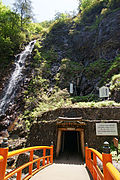Ikuno silver mine
The Ikuno silver mine ( Japanese 生 野 銀山 , Ikuno ginzan) in Hyōgo Prefecture was the most important silver mine in Japan for several centuries.
Overview
The Ikuno silver mine was discovered back in 807. In the 16th century it was greatly expanded by the local prince, the daimyo Yamana Suketoyo (山 名 祐 豊; d. 1580). Towards the end of the century the mine came under the direct control of the powerful men in the country, first under Oda Nobunaga , then under Toyotomi Hideyoshi , until it was administered by the Tokugawa shogunate from 1598. During the Edo period , the silver mine was the most productive in Japan for a long time.
After the Meiji Restoration in 1868, the mine fell to the new government, which invited the French engineer Jean Francisque Coignet (1835–1902) to modernize the operation. Finally, the government sold the mine to the Mitsubishi concern in 1896 . The mine also had the largest tin deposits in Japan. After the silver deposits were depleted, the mine mainly produced copper and zinc. The mine was closed at the end of March 1973, but can still be visited.
photos
literature
- S. Noma (Ed.): Ikuno Silver Mine . In: Japan. An Illustrated Encyclopedia. Kodansha, 1993. ISBN 4-06-205938-X , p. 590.
Web links
- Side of the silver mine
- Ikuno ginzan in the Kotobank
Coordinates: 35 ° 10 ′ 18 ″ N , 134 ° 49 ′ 10.7 ″ E







